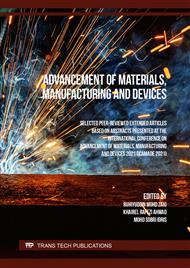[1]
J. M. Paris, J. G. Roessler, C. C. Ferraro, H. D. Deford, and T. G. Townsend, A review of waste products utilized as supplements to Portland cement in concrete,, Journal of Cleaner Production, vol. 121. Elsevier Ltd, p.1–18, May 10, (2016).
DOI: 10.1016/j.jclepro.2016.02.013
Google Scholar
[2]
A. P. Vieira, R. D. Toledo Filho, L. M. Tavares, and G. C. Cordeiro, Effect of particle size, porous structure and content of rice husk ash on the hydration process and compressive strength evolution of concrete,, Constr. Build. Mater., (2020).
DOI: 10.1016/j.conbuildmat.2019.117553
Google Scholar
[3]
R. Xiao et al., Strength, microstructure, efflorescence behavior and environmental impacts of waste glass geopolymers cured at ambient temperature,, J. Clean. Prod., (2020).
DOI: 10.1016/j.jclepro.2019.119610
Google Scholar
[4]
L. Hu, Z. He, and S. Zhang, Sustainable use of rice husk ash in cement-based materials: Environmental evaluation and performance improvement,, J. Clean. Prod., (2020).
DOI: 10.1016/j.jclepro.2020.121744
Google Scholar
[5]
S. Chandrasekhar, P. N. Pramada, and J. Majeed, Effect of calcination temperature and heating rate on the optical properties and reactivity of rice husk ash,, J. Mater. Sci., (2006).
DOI: 10.1007/s10853-006-0859-0
Google Scholar
[6]
R. M. Ferraro and A. Nanni, Effect of off-white rice husk ash on strength, porosity, conductivity and corrosion resistance of white concrete,, Constr. Build. Mater., (2012).
DOI: 10.1016/j.conbuildmat.2011.12.010
Google Scholar
[7]
S. Azat, A. V. Korobeinyk, K. Moustakas, and V. J. Inglezakis, Sustainable production of pure silica from rice husk waste in Kazakhstan,, J. Clean. Prod., (2019).
DOI: 10.1016/j.jclepro.2019.01.142
Google Scholar
[8]
C. D. Igwebike-Ossi, Potassium oxide analysis in rice husk ash at various combustion conditions using proton-induced X-ray emission (PIXE) spectrometric technique,, Int. J. Appl. Chem., (2016).
Google Scholar
[9]
A. Singh and B. Singh, Characterization of rice husk ash obtained from an industrial source,, J. Sustain. Cem. Mater., (2020).
Google Scholar
[10]
M. Thiedeitz, W. Schmidt, M. Härder, and T. Kränkel, Performance of rice husk ash as supplementary cementitious material after production in the field and in the lab,, Materials (Basel)., (2020).
DOI: 10.3390/ma13194319
Google Scholar
[11]
C. Fapohunda, B. Akinbile, and A. Shittu, Structure and properties of mortar and concrete with rice husk ash as partial replacement of ordinary Portland cement – A review,, International Journal of Sustainable Built Environment. (2017).
DOI: 10.1016/j.ijsbe.2017.07.004
Google Scholar
[12]
W. Xu, T. Y. Lo, and S. A. Memon, Microstructure and reactivity of rich husk ash,, Constr. Build. Mater., (2012).
Google Scholar
[13]
E.-H. Hwang, Y. S. Ko, and J.-K. Jeon, Effect of polymer cement modifiers on mechanical and physical properties of polymer-modified mortar using recycled artificial marble waste fine aggregate,, J. Ind. Eng. Chem., vol. 14, no. 2, p.265–271, (2008).
DOI: 10.1016/j.jiec.2007.11.002
Google Scholar
[14]
A. Muthadhi and S. Kothandaraman, Experimental Investigations of Performance Characteristics of Rice Husk Ash–Blended Concrete,, J. Mater. Civ. Eng., (2013).
DOI: 10.1061/(asce)mt.1943-5533.0000656
Google Scholar



